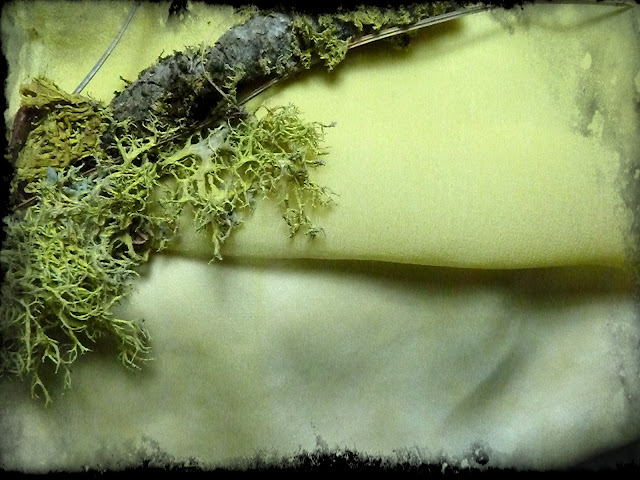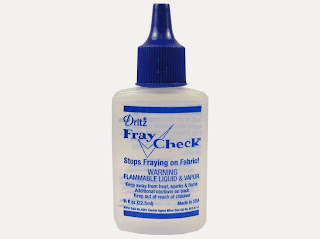Beautiful Natural Dye Results and Seasonal Earrings s
 |
| Wolf Moss Lichen & fabrics: top: Silk Chiffon Bottom: Silk Charmeuse |
I've been very excited and anticipating trying a bit of the dye solution I made from my cache of Wolf Moss Lichen that was gathered in Roslyn, Washington last month. I wanted to try small oddments of silk so that I might have a better idea of what to expect before I sacrificed a lovely silk scarf to this briney brew.. Thankfully, I have enough of the raw ingredients to make another batch which I will save along with the remainder if batch number one.
The top piece is silk chiffon that had been sitting in an alum mordant for longer than the piece of silk charmeuse had. It did make a difference in the depth of color - and also I did not microwave the charmeuese ( I hit the chiffon with a minute in the micro) which may also have affected the results. Both pieces of cloth were put in a glass and covered with dye solution and let set on the heater (gas) for an hour. I am thrilled with the color I got! It's a rich green cast yellow. A really a special color! I am now confident enough in the color to try it on a shibori tied scarf blank. I also want to see what the addition of another mordant will do - or not do. Some experimentation coming up.
My next planned experiment may be bracken ferns which we have in abundance - at least if I pick some before we have too many more heavy frosts.
The history of this fascinating, nearly fluorescent looking lichen is quite interesting and the following information is taken from the Washington State Department of Ethnobotany.
"....
Letharia vulpina
Wolf "Moss"
The
color ranges from a brilliant yellow green to a duller yellow ochre
under drier conditions. It is the easiest lichen to spot, noticible even
when driving at fast speed from the highway.
Habitat: Letharia vulpina is most commonly found in dry coniferous forests. The species also occurs in Europe southward to North Africa. The species is found on twigs and stumps of most conifers. In Washington, you won't find it in coastal Douglas-fir rain forests, but in drier inland Douglas-fir stands, where it can be very abundant. It seems to be adapted to summer dryness [in fact, the alga's photosynthetic maximum is 7oC, and doesn't drop much even to 0oC, (the freezing point)]. So it is active mostly during winter precipitation. There are, however, instances of the lichen found on bark of other trees, and human made substrates like houses and fence posts. It sometimes occurs on rocks.
Use: Used as a yellow dye. For this purpose it was boiled in water, alone or with Oregon grape bark. This dye was used mainly for basket materials and fibers. As a medicine, this lichen was boiled and taken in a weak solution for internal problems and, in stronger solution, was used to wash external sores and wounds.
This lichen is... poisonous that the Achomawi in Northern California used it to make poison arrowheads.
And how did the common name come about? It deals with the European usage, which (barbarians that they were) was destructive. It was mixed with ground glass and meat and used to kill wolves. The vulpinic acid is toxic, although it is not clear if the ground glass may have been enough to do the job. Perhaps it caused stomach perforations and allowed the vulpinic acid (note the name) to be readily absorbed.
Habitat: Letharia vulpina is most commonly found in dry coniferous forests. The species also occurs in Europe southward to North Africa. The species is found on twigs and stumps of most conifers. In Washington, you won't find it in coastal Douglas-fir rain forests, but in drier inland Douglas-fir stands, where it can be very abundant. It seems to be adapted to summer dryness [in fact, the alga's photosynthetic maximum is 7oC, and doesn't drop much even to 0oC, (the freezing point)]. So it is active mostly during winter precipitation. There are, however, instances of the lichen found on bark of other trees, and human made substrates like houses and fence posts. It sometimes occurs on rocks.
Use: Used as a yellow dye. For this purpose it was boiled in water, alone or with Oregon grape bark. This dye was used mainly for basket materials and fibers. As a medicine, this lichen was boiled and taken in a weak solution for internal problems and, in stronger solution, was used to wash external sores and wounds.
This lichen is... poisonous that the Achomawi in Northern California used it to make poison arrowheads.
And how did the common name come about? It deals with the European usage, which (barbarians that they were) was destructive. It was mixed with ground glass and meat and used to kill wolves. The vulpinic acid is toxic, although it is not clear if the ground glass may have been enough to do the job. Perhaps it caused stomach perforations and allowed the vulpinic acid (note the name) to be readily absorbed.
Plant
and habitat description, as well as the source of the common name from
Europe comes from Scott Kroken, a Ph.D. candidate at the University of
California, Berkeley, who is currently...."
Another excellent description of this fascinating plant can be found on Wikipedia.
Don't forget, we all "fall back" on Sunday - providing us with shorter days and time to knit, felt, paint, quilt and create .. that is if you have any energy left in the evenings which I generally don't !!




nice blog!
ReplyDeleteI'm jealous. All my 'art' is going into schoolwork. The only thing I'm working on is my a'la Dr Who, long, multi-colored scarf. But end of December I am on vacation and no school, so hopefully I can play some.
ReplyDeleteThat mossy fabric is fabulous!!
ReplyDeleteBeautiful greens.
ReplyDeleteWow Marie. Love it. I got out my natural dye book of recipes for walnuts. I'll post about it in a couple of days. Love this green and the crows are pretty cool, too!
ReplyDelete